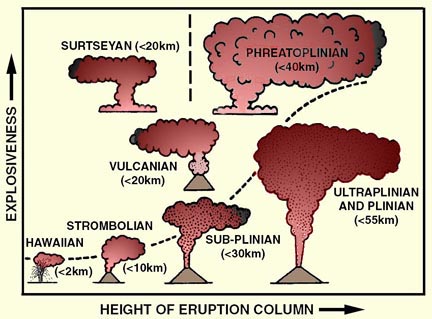
The diagram below demonstrates how the various eruption types can be expressed as a function of height of eruption column and explosiveness. These parameters can be quantified in ancient eruptions by measuring the dispersal and fragmentation of the erupted tephra deposits (e.g., Wright et al., 1980).
More specifically, D (the area of pyroclastic dispersal) is an indicator of the column height. It has been defined by Walker (1973) as the area enclosed by an isopach contour representing 1% of the maximum thickeness (0.01 Tmax). Similarly, F (fragmentation) is an indicator of the explosiveness of the eruption. It is defined as the percent of tephra <1mm, measured along an axis of dispersal where the isopach is 10% of Tmax (Walker, 1973). Calculations of D and F on ancient tephra deposits demonstrate that the various eruption types can be defined by variations in their explosiveness and the height of the eruption plumes, as revealed in the following diagram.
 |
|
|
Note that the hydrovolcanic eruptions (above dashed line) are often highly explosive, but typically display relatively low eruption columns. This apparent dichotomy is attributed to (1) rapid heat loss as water is converted to steam, and (2) condensation of the water during rise of the eruption column, which decreases its volume and increases its density. The increased density of hydrovolcanic plumes can cause them to collapse, often generating ground-hugging base surges which spread rapidly outward from the vent.